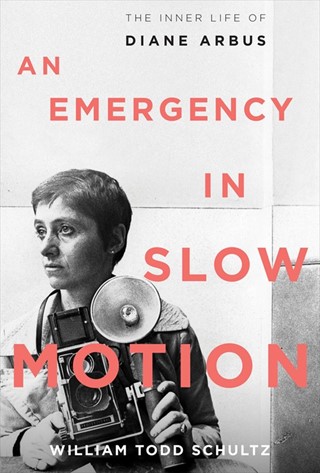William Todd Schultz digs deep into the inner life of celebrated and troubled photographer Diane Arbus, 40 years after her suicide
"She joked about being Jewish and rich and from a good family and running away from it all giddily. In a Guggenheim application of 1962 she describes her subjects: sideshows, secret photos of steam bathers, female impersonators. Locations include Times Square, Central Park, Automats, Grand Central Station, the Roller Derby, rodeos, circuses, Harlem dance halls, wax museums, pool houses and, above all, a place that would bewitch her mightily, Hubert’s Dime Museum and Flea Circus.
In October 1959 Arbus started work for Esquire magazine on an issue devoted to New York. This gave way to an independent photographic essay, a project on the city ranging from 'the posh to the sordid.' She visits Mother Cabrini, a disinterred saint. She checks out the Mr. Universe Health Parlor. She loiters in meat markets waiting for the heads. She meets Walter Gregory, 'the Madman from Massachussetts,' a legendary Bowery character. The mad man waved his finger in her face saying 'who was I?' He had just one eye, and his nose was folded over. 'I don’t press the shutter,' she tells Marvin Israel. 'The image does. And it’s like being gently clobbered.' Around the same time she wonders, 'I think it does, a little, hurt to be photographed.'
"I don’t press the shutter. The image does. And it’s like being gently clobbered" – Diane Arbus
In July 1960, Arbus’s 'The Vertical Journey: Six Movements of a Moment Within the Heart of the City' appeared in Esquire, along with captions of Arbus’s devising. The spread signaled her arrival. Already she was interested in blurring boundaries between the fantastical and the mundane. The closer one looks, the odder one’s objects of perception get. Flaws, always a particular fascination, have their way of rising to the surface. Hezekiah Trambles, 'the Jungle Creep,' comes off as far more affrighted than creepy. His position suggests he’s under attack. Mrs. Dagmar Patino, photographed at the Grand Opera Ball benefitting Boystown of Italy, is no less degraded. The photo is grainy. Her black eyes float pellucidly beneath a jewel of some sort holding her hair in place on top of her head. Her arms cross stolidly, a look of faint disapproval on her face. The scene is one big hallucinatory swirl. Nothing achieves clarity. We also meet Andrew Ratoucheff, a dwarf actor known for his imitations of Marilyn Monroe and Maurice Chevalier; a shirtless, tattooed Walter Gregory, his right eye sealed shut, lips oddly asymmetrical; the meditative Flora Knapp Dickinson, Honorary Regent of the Washington Heights Chapter of the Daughters of the American Revolution. Then there is 'person unknown' from the city morgue, tag affixed to his right big toe. The fact is, these are all persons unknown. Or if we think we know them, we know less than we think. What is freakier, anomalousness or normality?
All these human oddities Arbus compared to characters in a spooky fairy tale for grown-ups. Rumpelstiltskin-like, they stopped you in your tracks. If Arbus’s clicked image constitutes an answer, it applies equally to her subjects and to herself. 'There are always two things that happen,' she said. 'One is recognition and the other is that it’s totally peculiar. But there’s some sense in which I always identify with them.' The pictures are Arbus’s internal world externalized. The secrets she exposed were hers – theirs too, but hers."
In his new “psychobiography”, William Todd Schultz digs deep into the inner life of celebrated and troubled photographer Diane Arbus, 40 years after her suicide. Through interviews with her former subjects, Arbus’ writings and even her own therapist, the book attempts to shed light on the psyche that produced such unflinching art: black and white photographs of sideshow “freaks”, nudists, misfits and cross-dressers, often encountered in Central Park or Coney Island – characters in a “spooky fairy tale for grown-ups” as the photographer once put it. This extract conjures the kaleidoscopic range of Arbus’ subjects during the early 60s.
Extract from An Emergency in Slow Motion: The Inner Life of Diane Arbus by William Todd Schultz, published by Bloomsbury, priced £18.99.
Suggested Reading: AnOther's Fashion Equation found threads of inspiration from Diane Arbus in Jil Sander's A/W11 collection here.
